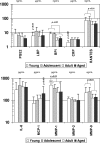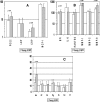Effects of age and oral disease on systemic inflammatory and immune parameters in nonhuman primates
- PMID: 18448617
- PMCID: PMC2446639
- DOI: 10.1128/CVI.00258-07
Effects of age and oral disease on systemic inflammatory and immune parameters in nonhuman primates
Abstract
This report evaluated systemic inflammatory and immune biomarkers in a cohort of Macaca mulatta (rhesus monkeys) maintained as a large family social unit, including an age range from <1 year to >24 years. We hypothesized that the systemic host responses would be affected by the age, gender, and clinical oral presentation of the population, each contributing to inflammatory and immune responses that would reflect chronic oral infections. The results demonstrated that the prevalence and severity of periodontitis, including missing teeth, increased significantly with age. Generally, minimal differences in clinical parameters were noted between the genders. Systemic inflammatory mediators, including acute-phase reactants, prostaglandin E(2) (PGE(2)), cytokines/chemokines, and selected matrix metalloproteinases (MMP), demonstrated significant differences among the various age groups of animals. Levels of many of these were increased with age, although PGE(2), RANTES, bactericidal permeability-inducing factor (BPI), MMP-1, and MMP-9 levels were significantly increased in the young group ( approximately 1 to 3 years old) relative to those for the older animals. We observed that in the adult and aged animals, levels of the systemic inflammatory mediators related to gingival inflammation and periodontal tissue destruction were significantly elevated. Serum antibody levels in response to a battery of periodontal pathogens were generally lower in the young animals, <50% of those in the adults, and were significantly related to aging in the cohort. The levels of antibodies, particularly those to Porphorymonas gingivalis, Fusobacterium nucleatum, and Tannerella forsythia, were most significantly elevated in animals with periodontal disease, irrespective of the age of the animal. These results provide a broad description of oral health and host responses in a large cohort of nonhuman primates from very young animals to the aged of this species. The findings afford a base of data with which to examine the ontogeny of host responses at mucosal sites, such as the gingival tissues.
Figures







Similar articles
-
Systemic inflammatory responses in progressing periodontitis during pregnancy in a baboon model.Clin Exp Immunol. 2010 Dec;162(3):550-9. doi: 10.1111/j.1365-2249.2010.04202.x. Clin Exp Immunol. 2010. PMID: 21070210 Free PMC article.
-
Rat model of polymicrobial infection, immunity, and alveolar bone resorption in periodontal disease.Infect Immun. 2007 Apr;75(4):1704-12. doi: 10.1128/IAI.00733-06. Epub 2007 Jan 8. Infect Immun. 2007. PMID: 17210663 Free PMC article.
-
Periodontitis in pregnant baboons: systemic inflammation and adaptive immune responses and pregnancy outcomes in a baboon model.J Periodontal Res. 2014 Apr;49(2):226-36. doi: 10.1111/jre.12099. Epub 2013 May 28. J Periodontal Res. 2014. PMID: 23710643 Free PMC article.
-
Use of Nonhuman Primates in Periodontal Disease Research: Contribution of the Caribbean Primate Research Center and Cayo Santiago Rhesus Colony.Am J Primatol. 2025 Feb;87(2):e23724. doi: 10.1002/ajp.23724. Am J Primatol. 2025. PMID: 39902755 Review.
-
Biological activities of lipopolysaccharides from oral bacteria and their relevance to the pathogenesis of chronic periodontitis.Sci Prog. 1995;78 ( Pt 1):19-34. Sci Prog. 1995. PMID: 7597416 Review.
Cited by
-
Identification and validation of a classifier based on hub aging-related genes and aging subtypes correlation with immune microenvironment for periodontitis.Front Immunol. 2022 Nov 1;13:1042484. doi: 10.3389/fimmu.2022.1042484. eCollection 2022. Front Immunol. 2022. PMID: 36389665 Free PMC article.
-
Immune system transcriptome in gingival tissues of young nonhuman primates.J Periodontal Res. 2016 Apr;51(2):152-63. doi: 10.1111/jre.12293. Epub 2015 Jun 16. J Periodontal Res. 2016. PMID: 26077888 Free PMC article.
-
Systemic inflammatory responses in progressing periodontitis during pregnancy in a baboon model.Clin Exp Immunol. 2010 Dec;162(3):550-9. doi: 10.1111/j.1365-2249.2010.04202.x. Clin Exp Immunol. 2010. PMID: 21070210 Free PMC article.
-
Acquisition of oral microbes and associated systemic responses of newborn nonhuman primates.Clin Vaccine Immunol. 2014 Jan;21(1):21-8. doi: 10.1128/CVI.00291-13. Epub 2013 Oct 30. Clin Vaccine Immunol. 2014. PMID: 24173024 Free PMC article.
-
Oral microbiome interactions with gingival gene expression patterns for apoptosis, autophagy and hypoxia pathways in progressing periodontitis.Immunology. 2021 Apr;162(4):405-417. doi: 10.1111/imm.13292. Epub 2021 Jan 4. Immunology. 2021. PMID: 33314069 Free PMC article.
References
-
- Abraham, C. M., and D. R. Ownby. 2005. Ontogeny of the allergic inflammatory response. Immunol. Allergy Clin. N. Am. 25:215-229. - PubMed
-
- Agrawal, A. A., A. Kapley, R. K. Yeltiwar, and H. J. Purohit. 2006. Assessment of single nucleotide polymorphism at IL-1A+4845 and IL-1B+3954 as genetic susceptibility test for chronic periodontitis in Maharashtrian ethnicity. J. Periodontol. 77:1515-1521. - PubMed
-
- Albandar, J. M., L. J. Brown, and H. Loe. 1997. Putative periodontal pathogens in subgingival plaque of young adults with and without early-onset periodontitis. J. Periodontol. 68:973-981. - PubMed
-
- Annacker, O., R. Pimenta-Araujo, O. Burlen-Defranoux, and A. Bandeira. 2001. On the ontogeny and physiology of regulatory T cells. Immunol. Rev. 182:5-17. - PubMed
Publication types
MeSH terms
Substances
Grants and funding
LinkOut - more resources
Full Text Sources
Miscellaneous

